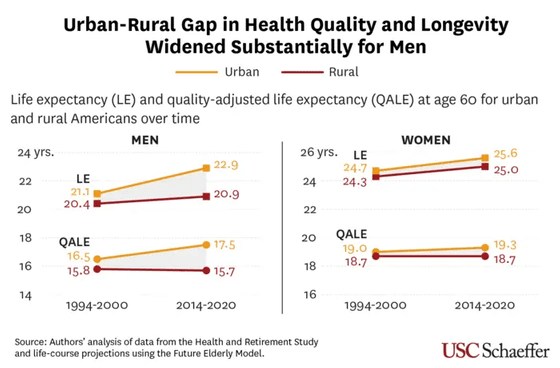It turns out that men who live in rural areas have shorter life expectancies than men in cities. Why?

Urban environments are harmful to mental and physical health. For example,
The urban–rural gap in older Americans' healthy life expectancy - Chapel - The Journal of Rural Health - Wiley Online Library
https://onlinelibrary.wiley.com/doi/10.1111/jrh.12875
Growing divide: Rural men are living shorter, | EurekAlert!
https://www.eurekalert.org/news-releases/1059124
Rural Americans are dying younger, living less healthy lives, alarming report reveals
https://studyfinds.org/rural-americans-dying-younger/
In a study published in the peer-reviewed medical journal The Journal of Rural Health, Jack M. Chappell and his colleagues from the University of Southern California's Schaefer Center for Health Policy and Economics conducted simulations to predict the life expectancy and length of time that people can live in good health as they approach old age.
The health data was taken from the Health and Retirement Study, a health survey of approximately 20,000 middle-aged and elderly people conducted by the University of Michigan. The simulation was also conducted using the Future Elderly Model, a microsimulation model that predicts the lifespan of elderly people on an individual basis.
The analysis found that men living in rural areas are more likely to die earlier than their urban counterparts and are less likely to enjoy a healthy old age.

Specifically, rural men who turned 60 between 2014 and 2020 lived two years less than urban men of the same age, a difference that is nearly three times greater than between 1994 and 2000. They also lived 1.8 fewer healthy years, a figure that also doubled over the 20-year period.
Meanwhile, regional disparities are smaller for women than for men, and the disparities are widening much more slowly over time.
The graph below summarizes the results, comparing

by USC Schaeffer Center for Health Policy & Economics
To understand why these differences exist, Chappell and his colleagues looked at a variety of factors, including chronic disease, disability rates, and lifestyle choices. They found that people living in rural areas were more likely to smoke, be obese, and suffer from chronic diseases, which could lead to poorer health in later life.
One of the biggest factors widening the health gap is education, and when the research team simulated a scenario in which the educational levels of urban and rural areas were the same, the gap was reduced by half. In particular, people with a college degree had very good health regardless of where they lived.
The findings highlight the growing demand for care in rural areas, as well as the accelerated ageing of the population and the resulting decline in potential caregivers as young people move to cities. Rural areas also tend to have fewer medical staff than urban areas.

'Rural residents have higher rates of chronic diseases, which poses serious challenges to healthy aging,' said Chappell. 'The ageing population and declining number of doctors will place increasing burdens on local governments and pose major challenges in providing medical care to people who will face health problems in the future.'
'To close regional differences in healthy life expectancy among older adults, we need to encourage better health behaviors starting early in life and implement broader social and economic improvements, particularly in rural areas,' said study co-author Brian Tysinger.
Related Posts:
in Science, Posted by log1l_ks







